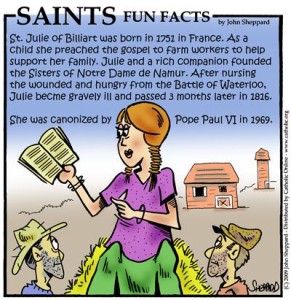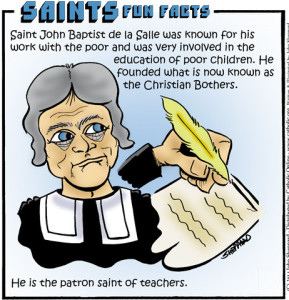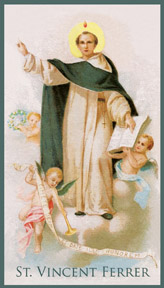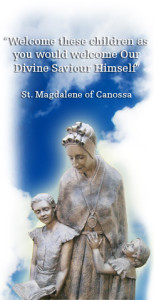
St. Magdalene of Canossa (1774-1835)
Image: Canossian School
(Vatican) Born in Italy Verona of a noble and wealthy family, Magdalen was the third of six children–by the way of painful events such as her father’s death at the age of 5 and her mother’s second marriage, illness and misunderstanding, the Lord guided her towards unforeseen paths.
Drawn to the Love of God at the age of 17, she planned to consecrate her life to God and twice tried her vocation at a Carmel, however the Holy Spirit urged Magdalen to follow a new path to allow herself to be loved by Jesus Crucified, to belong to Him alone, in order to dedicate herself exclusively to those in greatest need.
Magdalene returned to her family and being compelled by sad events and tragic political circumstances at the end of the 18th Century, she nurtured her true vocation in the depth of her heart and went on with life at ‘Canossa Palace’ shouldering the burden of running her families large estate.
With complete dedication Magdalene carried out her daily tasks and widened her circle of friends, while at the same time remaining open to the mysterious action of the Holy Spirit who gradually molded her heart and enabled her to share in the love of the Father for mankind revealed by Jesus’ complete and supreme offering of Himself in the Cross and by the example of the Holy Virgin Mary–Moved by that love, Magdalene responded to the poor, hungry for food and instruction, understanding and the Word of God.
Magdalene would find them in the suburbs of Verona, where the echoes of the French Revolution, the occupation by various foreign powers and the Verona uprising had left evident signs of devastation and human suffering. Magdalene gave special attention to Girls living in poverty, together with those who had been abandoned, concentrating her efforts and energy on building up an institution for them.
In 1801 Magdalene’s work earned Napoleon’s admiration for the ‘Charitable Establishment’ erected in a suppressed Convent in a poor area.
Magdalene’s life was marked by suffering and trials, she lived in a society of contrasts between the very rich and those living in extreme poverty–the society that Magdalen had grown up in was forgetful of God, dominated by arrogance and privilege.
It was in this environment that Magdalene discovered deep within herself the desire to share the life of Jesus Christ in the Salvation of many who had been abandoned in their poverty, exploited by the egoism of the wealthy and oppressed by the evils of her day. Magdalen began to give of herself without reservation to children, youth and women who faced economic hardship, as well as moral, spiritual, intellectual and family poverty.
In 1808 Magdalene left the ‘Canossa Palace’ indefinitely with some friends, establishing herself in the poverty-stricken district of San Zeno where she found delight in giving of herself, serving the neediest persons with the Heart of Christ.
Charity is like a blazing fire — Magdalene opened her heart to the Holy Spirit who guided her to the poor in other cities: Venice, Milan, Bergamo, Trent…In only a few short decades the number of her homes increased and her religious family grew in the service of the Kingdom of God.
The Love of the Crucified and Risen Jesus, burnt in Magdalene’s heart together with her friends, became a witness for that same love in five specific areas:
- Charity Schools, providing an all around formation geared to pupils status in life;
- Catechesis given to all classes of people, with special attention to those most ignorant of Christianity;
- Support to Women patients in hospitals;
- Residential Seminars, to train young teachers for rural areas and valuable helpers for Parish Priests in the pastoral activities;
- Yearly courses of Spiritual exercises for Ladies of the nobility, with the aim of deepening their spiritual life and involving them in various charitable works–Later on, this activity was offered to all those who had a desire for it.
Magdalene vision was that of a missionary spirit often stating that she was prepared to go anywhere and do anything so that Jesus would be known and loved but this particular dream was not to be realized in her lifetime.
Today, the Canossian Daughters of Charity living the spirit of Magdalene are present in 35 countries around the world and the ‘Canossian Family’ includes the ‘Canossian Sons of Charity’ (Priests/Brothers) together with the Lay Canossians/Secular Missionaries witnessing charity in all walk of Christian life.
In 1988 Magdalene was Canonized by Pope Saint John Paul II
Magdalene is remembered as a true witness to the constant and freely given Love of God — We give Thanks to Him for the Gift of this Mother and Sister of ours and through her intercession we ask that we may love Him as she did, above all other things and make Him known to others by the way we live our lives.
More here from Canossian Daughters of Charity
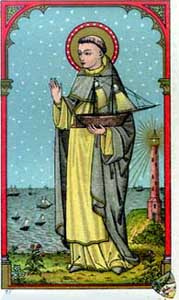
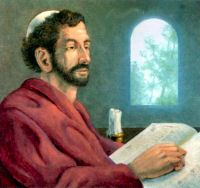
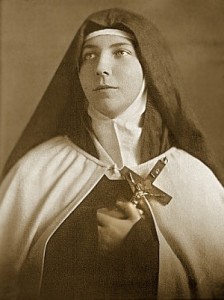
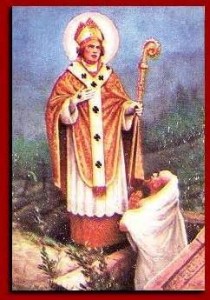

 Saint Casilda of Toledo
Saint Casilda of Toledo